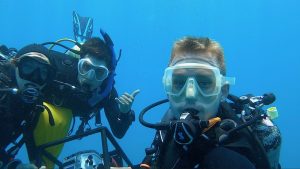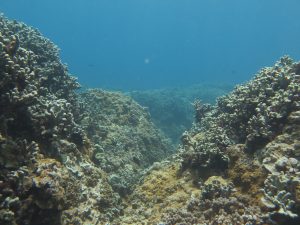Since 2014, the Smith Lab has been collecting large area imagery to monitor the coral reefs of Maui’s leeward (protected) coast using structure from motion (SfM) technology. Through this work, researchers have captured how the reefs grow and change through time in the midst of a variety of global and local disturbances and stressors. Most notably, this time-series is the first of its kind to capture a coral reef’s response to sequential “bleaching” events (in 2015 and 2019), allowing scientists to identify patterns of coral growth and survivorship.
The findings from this study were recently published on July 31 in the journal PLOS ONE by lead author, Smith Lab alum Dr. Orion McCarthy, with coauthors Dr. Jennifer Smith and Morgan Winston from the Univeristy of Arizona.
Ultimately, the team discovered that while some corals bleach and die due to bleaching, others show evidence of acclimatization, with less severe bleaching and higher survivorship observed during and following the second bleaching event. Surprisingly, they also found that bleaching didn’t appear to impact coral growth rates of those surviving corals. These findings can help inform ongoing coral conservation and restoration efforts, and provide hopeful signs of resilience for Maui’s reefs.
The findings of this study were covered widely by various media outlets and can be found in more detail in this UCSD press release, a story by Hawaii Public Radio, news coverage by CBS & NBC San Diego, and articles on Earth.com and Technology Networks.


Smith Lab team members, Orion McCarthy, Sam Clements, and Mitch Smelser also recently revisited Maui, almost exactly one year following the devastating wildfires that ravaged Lahaina, to conduct follow-up surveys of the reefs there. They established a handful of new survey sites off the coast of Lahaina to improve the resolution of surveys in the area directly adjacent to the area of greatest wildfire impact, as well as the location of the temporary dump site near Olowalu for the massive amounts of resulting toxic debris.
The scientists were pleasantly surprised to discover that there were no visible catastrophic impacts from the 2023 wildfires one year later. This gave our team immense hope and a sense of cautious optimism in the face of such a devastating disaster, as it revealed that Lahaina’s reefs are persevering. Continued monitoring will be necessary to identify potential long-term impacts of runoff and the re-development of Lahaina, but these preliminary signs of resilience give us hope for the future of Maui’s reefs.
To learn more about the Smith Lab’s coral reef research in Maui, click here.


